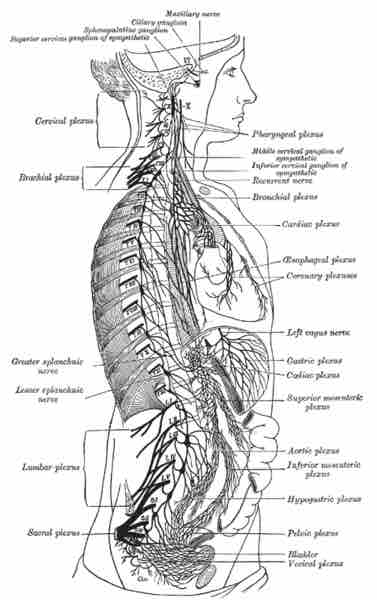Sympathetic Nervous System Physiology
Alongside the other two components of the autonomic nervous system, the sympathetic nervous system aids in the control of most of the body's internal organs. Stress—as in the hyperarousal of the flight-or-fight response—is thought to counteract the parasympathetic system, which generally works to promote maintenance of the body at rest.

Sympathetic nervous system
The sympathetic nervous system extends from the thoracic to lumbar vertebrae and has connections with the thoracic, abdominal aortic, and pelvic plexuses.
The sympathetic nervous system is responsible for regulating many homeostatic mechanisms in living organisms. Fibers from the SNS innervate tissues in almost every organ system and provide physiological regulation over diverse body processes including pupil diameter, gut motility (movement), and urinary output.
The SNS is perhaps best known for mediating the neuronal and hormonal stress response commonly known as the fight-or-flight response, also known as sympatho-adrenal response of the body. This occurs as the preganglionic sympathetic fibers that end in the adrenal medulla secrete acetylcholine, which activates the secretion of adrenaline (epinephrine), and to a lesser extent noradrenaline (norepinephrine).
Therefore, this response is mediated directly via impulses transmitted through the sympathetic nervous system, and also indirectly via catecholamines that are secreted from the adrenal medulla, and acts primarily on the cardiovascular system.
Messages travel through the SNS in a bidirectional flow. Efferent messages can trigger simultaneous changes in different parts of the body.
For example, the sympathetic nervous system can accelerate heart rate, widen bronchial passages, decrease motility of the large intestine, constrict blood vessels, increase peristalsis in the esophagus, cause pupillary dilation, piloerection (goose bumps) and perspiration (sweating), and raise blood pressure.
Afferent messages carry sensations such as heat, cold, or pain. Some evolutionary theorists suggest that the sympathetic nervous system operated in early organisms to maintain survival since the sympathetic nervous system is responsible for priming the body for action. One example of this priming is in the moments before waking, in which sympathetic outflow spontaneously increases in preparation for activity.
The Fight-or-Flight Response
The fight-or-flight response was first described by Walter Bradford Cannon. His theory states that animals react to threats with a general discharge of the sympathetic nervous system, priming the animal for fighting or fleeing. This response was later recognized as the first stage of a general adaptation syndrome that regulates stress responses among vertebrates and other organisms.
Catecholamine hormones, such as adrenaline or noradrenaline, facilitate the immediate physical reactions associated with a preparation for violent muscular action. These include the following:
- Acceleration of heart and lung action.
- Paling or flushing, or alternating between both.
- Inhibition of stomach and upper-intestinal action to the point where digestion slows down or stops.
- General effect on the sphincters of the body.
- Constriction of blood vessels in many parts of the body.
- Liberation of nutrients (particularly fat and glucose) for muscular action.
- Dilation of blood vessels for muscles.
- Inhibition of the lacrimal gland (responsible for tear production) and salivation.
- Dilation of pupil (mydriasis).
- Relaxation of bladder.
- Inhibition of erection.
- Auditory exclusion (loss of hearing).
- Tunnel vision (loss of peripheral vision).
- Disinhibition of spinal reflexes; and shaking.
In prehistoric times, the human fight-or-flight response manifested fight as aggressive, combative behavior and flight as fleeing potentially threatening situations, such as being confronted by a predator.
In current times, these responses persist, but fight-and-flight responses have assumed a wider range of behaviors. For example, the fight response may be manifested in angry, argumentative behavior, and the flight response may be manifested through social withdrawal, substance abuse, and even television viewing.
Males and females tend to deal with stressful situations differently. Males are more likely to respond to an emergency situation with aggression (fight), while females are more likely to flee (flight), turn to others for help, or attempt to defuse the situation (tend and befriend). During stressful times, a mother is especially likely to show protective responses toward her offspring and affiliate with others for shared social responses to threats.